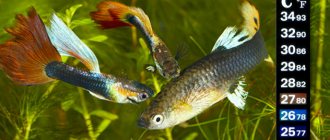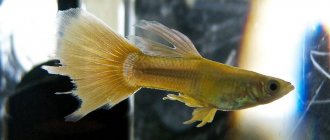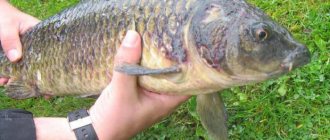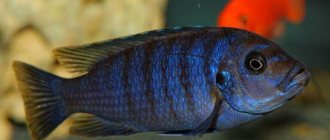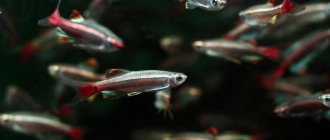Post Views: 1,801
4.4
(5)
The task of populating your first aquarium seems simple only at first glance. The variety of fish is impressive, which will only complicate the choice of a novice aquarist. Some of the inhabitants of the aquarium require such specific conditions that it will be extremely difficult for a beginner to create them. An experienced aquarist will probably tell you that you should start with unpretentious fish. After all, without basic knowledge in biology (microbiology), hydrochemistry and other complex disciplines, as well as an understanding of the structure and “life” of an artificial reservoir, it will not be easy to maintain your first aquarium. Only the hardiest fish will be able to survive the inept experiments of the aquarium owner.
Beginner aquarists should pay attention to those fish for which a wide range of water parameters will be acceptable. At the same time, there is no need to create any special aquatic environment for them. It is enough to follow a number of simple recommendations, and then all the inhabitants of the aquarium will be quite comfortable in it.
There are many fish that are great for any beginner aquarist. Among all the unpretentious species, according to experienced aquarists, we can make the “top 10”.
Guppy
Without hesitation, this small fish can be placed immediately in first place in the ranking. Its maintenance is extremely simple, and the experience gained will become indispensable for further increasing the diversity of your aquarium.
Guppies are famous for their incredible variety of colors, and just as importantly, they will feel great in an aquarium of any size. An ideal option would be an aquarium of 50 liters or more, where 6-10 fish live in dense thickets. Thanks to their peaceful nature, guppies will be able to live with other species without any conflicts. The main thing is to protect them from those fish that are prone to biting the fins of other inhabitants of the aquarium. Otherwise, the males will quickly lose their excellent veiled tails.
After spawning of viviparous guppies, fully formed fry will appear in the aquarium, ready to feed on their own. This simplifies the task of the aquarist even more, because even in a general aquarium nothing will interfere with this procedure. A guppy's diet can consist of various foods:
alive; frozen; dry.
Fish a lot of fish in a dream
Not long ago I had a strange dream. In a dream, I am walking with my classmate (I haven’t seen her for a long time, sometimes we communicate on the Internet, our relationship used to be very good), we go and talk with her about fish. She says she loves carp, I love other fish. I look down and see that we are walking, as it were, on glass, and under it there are a lot of different fish. This doesn't surprise me. We go further, we reach some street and see along the walls there is a huge amount of all kinds of fish, mostly smoked - it lies everywhere, right on the floor. I tell my friend that I don’t like smoked. My friend keeps talking about her carp, but they don’t seem to be there. And I promise her that we will buy her carp. All. Dream Interpretation Fish a lot of fish
Danio rerio
Since zebrafish belong to schooling fish, the group formed in the aquarium should consist of 6 or more individuals. An elongated aquarium with a capacity of more than 30 liters is suitable for these active inhabitants. Despite their increased activity, zebrafish will not offend any of their neighbors. But they will be very “happy” to see living plants. These fish are most comfortable near the surface of the water.
Although the fish is a spawning fish, there is nothing complicated in the spawning procedure in this case. Even novice aquarists can handle it without hassle.
The “standard” coloration for these fish is considered to be striped. However, there are also individuals with a pronounced leopard pattern, and genetically modified representatives of the species (from the GLO series). It is customary to feed them flake-like dry food floating on the water surface.
Fishes in the Indian Ocean
The fauna of the Indian Ocean has not been fully studied. In warm waters you can find a variety of marine animals. Fishing is carried out off the coast of the Indian Ocean. The fishery is mainly of local importance, however, a large amount of fish is also supplied to world markets. In addition, the Indian Ocean is rich in various natural resources. The inhabitants of the Indian Ocean cannot always be eaten. For example, the Bay of Bengal is very rich in fish stocks, but the technical backwardness of fishing and the low degree of knowledge of the waters of the bay prevent fishermen and large companies from catching fish. Fishing occurs during the winter monsoon, which is characterized by light winds and sunny weather. Some fish species are dangerous or troublesome to humans, as are the Indian Ocean jellyfish.
sword bearer
These rather large fish from the viviparous category are quite suitable for any novice aquarist. Often in aquariums you can find individuals with a length of 8-10 cm. They are easily recognized by the xiphoid process located on the caudal fin. As a result of successful selection, many swordtails have been bred, differing in their colors and even body shape.
For such jumping fish, you will need an aquarium of 50 liters or more (necessarily with a lid). Swordtails prefer to live in “harems”, where 2-3 females coexist with one male. Otherwise, male hostility cannot be avoided. It is recommended to plant the aquarium with live plants. The fry of the swordtail will appear fully formed, which will further simplify the task of the aquarist. The life cycle of these fish will be 3-5 years.
African cornflower haplochromis (Jackson's)
A popular fish from the large family of Malawian cichlids, living in the lakes of the Malawi National Park, is endemic. It has a luxurious blue color, its shade depends on the living conditions of the fish. In nature, individuals grow up to 17 cm in length, but, despite their quite decent size, they are distinguished by a calmer disposition than other African cichlids. In addition, there are representatives of the frontoz variety - the size of these fish reaches 35 cm.
Naturally, such large aquarium inhabitants need large, spacious “apartments”, especially if it means keeping several fish at once
Like all cichlids, African cornflower haplochromis are predators, and they need to select neighbors with caution
Mollies
Another type of viviparous fish. The size of females can reach 10 cm, but male mollies will be somewhat smaller. The most popular fish are those that are black in color.
Through the work of breeders, many color variations of mollies have been successfully developed. Beginners are advised to pay attention to the sailing mollies (mollies velifira) . It is distinguished from its relatives by the swiftness of its movements, as well as the presence of a highly developed dorsal fin. But such fish often show aggression towards their neighbors.
Mollies, like other carp-toothed viviparous species, are suitable for aquariums from 50 liters. In this case, the number of males should be somewhat larger. These fish will be quite comfortable among natural driftwood and living plants. The water in the tank should be warm and have medium hardness.
Mollies coexist quite peacefully with most aquarium fish. Cases of aggression are extremely rare. They reproduce simply and even unpredictably. The emerging fry will be fully formed and will be able to feed on their own.
Aquarium fish for beginners - 19 best species
Launching the first aquarium is a responsible process that requires attentiveness from the owner. And now, the plants have been planted, the decorations have been arranged, the equipment is working properly - you have figured out where to start the aquarium, completed the first steps and now it’s time to choose which fish to get.
Choosing aquarium fish, given the variety of species, shapes and colors, can be difficult. In such a situation, beginners buy the most beautiful fish without thinking about the requirements and preferences of the future pet, and in vain. A thoughtless purchase can lead to dire consequences - unable to provide proper care for the fish, the owner ends up left alone. Therefore, before purchasing, you should read the detailed description of the best aquarium fish for beginners, not forgetting to take into account the size of the tank and the compatibility of future pets.
Ancistrus
These fish are well known as “stuck catfish”. The oral apparatus of ancistrus has changed during evolution and has become a kind of “suction cup”. Thanks to this feature, the catfish will be able to stay on any surface (including vertical ones). With the help of this suction cup, the fish is able to collect fouling that appears on algae, which is the main part of its diet. As a result, ancistrus not only receive food, but also maintain the aquarium in exemplary cleanliness.
They grow up to 10-12 cm. The body of the ancistrus is dark gray and covered with white spots. There are both completely white individuals and fish with veil fins. Any 50-liter tropical aquarium will be an excellent home for ancistrus. It must contain natural driftwood, which the fish most like to scrape off in the process of obtaining the cellulose necessary for life.
Ancistrus can also harm living plants. But they get along quite peacefully with other fish. If a male and a female are adjacent to the aquarium, then spawning can occur at any time.
Snails fighting algae
Gastropods are excellent aquarium cleaners. The main advantage of snails is their ability to process absolutely any contaminants that may appear in the aquarium:
- Leftover food.
- Waste products of other inhabitants.
- Dying parts of vegetation.
- Plaque from the walls of the aquarium, decorative elements and equipment.
- Film from the water surface.
- Dead remains of the inhabitants.
The behavior of some varieties serves as an index of cleanliness in the container.
Disadvantages of using snails:
- Low rate of destruction of unicellular algal colonies.
- Rapid, uncontrolled population growth.
- When breeding, eggs are left on cleaned surfaces.
- Excretion of a large amount of own waste products.
Types of snails suitable for cleaning freshwater aquariums:
- Theodoxus - 2 cm. The shell is round in shape with various patterns. It begins to eat up aquarium plants only if there is no grassy coating on the stones and walls of the container.
- Septaria (turtle) - up to 3 cm. Flat shell. It feeds only on single-celled algal fouling. Does not eat cultivated flora.
- Ampularia - grows up to 10 cm. The shape of the shell is spiral, the colors are bright. When there is a lack of food, it eats plants. Predatory fish pose a threat to this species of snail.
- Javan Corbicula (golden bivalve) is a mollusk up to 2 cm in size. Quickly filters the water in the aquarium. 1–2 individuals are enough to clean 50–80 liters. Reproduces 2 times a year. Burying into the ground, it can damage the root system of plants.
- Helena - grows no more than 2 cm. The shell has the shape of a cone. Likes to burrow into the ground. It is used to control populations of other snails, as it feeds on living and dead individuals. Predator.
And also Neretina snails:
- Tiger - 2.5 cm. Round shell with zigzag lines of orange and brown color.
- Zebra - 3.5 cm. The color of the shell is light brown, dirty green with dark stripes. The body is gray or brick in color.
- Horned - 1.4–2 cm. On the rounded shell there are 1–2 pairs of horn-like processes. Color: light yellow, dirty yellow.
- Red dotted - up to 2 cm. The shell is orange in shades with black dots arranged in a row.
- Olive - 1.5–2 cm. Dark olive color with frequently spaced longitudinal lines of dark color.
- Spiked - 1.5–1.8 cm. The shape of the shell is flattened with rows of growths similar to spikes.
Ternetia
This miniature fish does not require special care, which makes it an attractive object for novice aquarists. Ternetia will grow up to 3-4 cm. It is easy to distinguish by its silvery body and three transverse stripes.
The species is characterized not only by veiled forms, but also by albino ones. (GloFish thornets with bright fluorescent coloring) are also in demand
It is better to keep such fish in aquariums of 40 liters or more. Ternetia is considered to be a schooling fish, so the number of individuals living in the aquarium should be at least 6.
Feeding this species is very simple - any food is easily eaten by the flock. In search of food, thornets rush to the surface or stay in the middle layers. The reproduction processes are somewhat more complicated, so beginners are advised to first familiarize themselves with the theory. The life cycle of individuals is 3-4 years.
Carp
Popular representatives of orderlies from the carp fish family are gyrinocheil species and the Siamese algae eater (Crossocheilus). Labio and frenatus are less popular.
All fish have an aggressive character. It is necessary to select neighbors for carp fish with special attention, otherwise they will start fights among themselves. Undemanding to food and habitat.
Cockerel
Males that are intolerant of each other are often called “fighting” fish. Experts classify the betta as a labyrinth fish (due to the presence of a special respiratory organ - the labyrinth). In the process of breathing, the cockerel uses atmospheric air, which forces it to periodically rise to the surface. As a result, the betta will be able to live even in small aquariums without a forced aeration system.
The length of adult cockerels will be 5-6 cm. This variety is also distinguished by pronounced sexual dimorphism - females lack luxurious tails and are smaller in size. Breeders managed to develop more than 70 varieties of this breed, which have different fins and different colors.
A small 7 liter aquarium is also suitable for a betta. Although it is better to get a 20-liter tank. Although the presence of an aeration system is not a prerequisite, it is still better to install a filter. To prevent damage to the labyrinth organ of bettas, the air temperature above the water should be kept warm.
During the breeding process, males construct an improvised nest from bubbles, where they then place the eggs. Until the fry are formed, the cockerel continues to care for the constructed nest.
Potassium fertilizer for aquarium
The nitrate and phosphate fertilizers we make contain potassium (we isolated it separately), but the amount is usually not enough to maintain potassium at the required level and we have to add it additionally.
To produce potassium fertilizer, potassium sulfate (K2SO4) or potassium sulfate is used. This salt does not contain nitrates and phosphates, so you do not have to worry about exceeding their concentration when applying potassium fertilizer. Potassium fertilizer is produced in the same way as nitrate and phosphate fertilizers.
Dissolve 110 g of K2SO4 in 1 liter of water. The resulting fertilizer will contain 50 g/l of potassium. Accordingly, when adding 1 ml of fertilizer to 10 liters of aquarium water, the potassium concentration will rise by 5 mg/l.
As you can see, making macrofertilizers yourself is not at all difficult. In microfertilizers the principle is the same, but there are many more components. We will talk about this in the next article.
Author Igor Lakin
A COUPLE OF LIFE HACKS FOR EVERYONE WHO READ THE ARTICLE AND DECIDED TO MAKE AQUARIUM FERTILIZERS THEMSELVES.
1. Having prepared the self-mix, we have a problem, how to store it? Fertilizer is a good nutrient medium for microorganisms, in particular algae. If you do not store the UDO liter in refrigerators, then all sorts of fouling can often form on the walls of the container, and the fertilizer itself deteriorates.
To prevent this, write down the trick, I dictate =) Take ~ 20 ml. any algaecide (glutaraldehyde), for example, from Medosa.
Pour in these 20 ml. into the prepared 1 liter fertilizer solution and voila, it can be stored at room temperature and will not turn sour.
For anyone who is worried about the effect of glutaraldehyde on their herbalist, we hasten to reassure that such a small dose will not affect the herbalist’s condition in any way. On the contrary, it will improve it. Because glutaraldehyde in small doses is beneficial to plants because it is a source of carbon – C.
In turn, being in the fertilizer solution, the algaecide will play the role of a preservative, preventing any bug from developing.
2. And finally, one more piece of advice. It is understood that to prepare fertilizer we will need accurate scales that measure weight in grams. You can buy such scales on AliExperse, let’s say, these ones + will come in handy in the kitchen.
But there are specialized electronic measuring spoons. They are very convenient for measuring even the smallest portions of fertilizers. If you decide to purchase such a spoon, we recommend taking professional things like the Ista Digital Spoon Scale - a special, one might say aquarium spoon, that will ensure accurate dosing of any chemical or additive up to 300 grams in 0.1 g increments.
Editorial: Multi-colored axolotls
We do not recommend buying similar spoons to Ali (at least read the reviews carefully) because there have been sad precedents with their accuracy. How to check accuracy? Weight of 10 ruble coin = 5.65 grams. Put it in and check =)
Recommended Video
Subscribe to our YouTube channel so you don't miss anything
Category: Aquarium Articles / Aquascaping | 984 | Date: 12-02-2020, 20:47 |
We also recommend reading:
- — Pseudoplatistoma tiger
- — Corridoras nanus
- — Black bugrus
- — Ornatus black phantom
- — Geophagus red-headed Tapajos
Corydoras speckled
Corydoras belong to an extremely popular group of aquarium catfish. They are distinguished not only by their peaceful nature, but also by their curious behavior. Corydoras are able to masterfully clean the bottom of their aquarium from all food debris.
If the length of an adult male reaches only 4-6 cm, then the female will be somewhat larger - already up to 7 cm. The color of the individuals will be gray-olive with many dark spots. But the color of the abdomen will be pinkish-olive.
Experts know speckled corydoras as schooling fish. In an aquarium, it is better for them to live in flocks of 4-6 specimens. In order for Corydoras to live in an aquarium as comfortable as possible, its volume should be 30 liters or more. It is important to ensure that the surface of the soil is free of any sharp edges, otherwise the sensitive antennae of the fish may suffer irreparable damage. Catfish love to swim into the thick of plants and dig into the soil.
Corydoras get along quite peacefully with most aquarium fish. Although catfish belong to the family of spawning fish, their reproduction will not cause any special problems for the aquarist. In a favorable environment they will live for 8-10 years.
Characinaceae
This family includes such unassuming species as neons, tetras, thorn fish and others. They are suitable for a small aquarium, but are more demanding in terms of maintenance than the aforementioned representatives of Labyrinth and Carp. To care for fish, you will need to plant living vegetation, soft acidic water and regular partial fluid changes.
Ternetia
Small fish up to 5 cm long. The color of thornets is usually silver, but depending on the composition and parameters of the aquatic environment, pets can turn dark or transparent. They live in a school of relatives, are unpretentious in their diet and get along well with other peaceful fish in the aquarium. They need good filtration and aeration.
Ternetia
Neons
Small neons are magical aquarium fish for beginners, as a school of neons always attracts the attention of others. A distinctive feature of all types of neon is considered to be a longitudinal strip, which is capable of reflecting rays of light and shining. In addition to their spectacular appearance, neons are loved for their unpretentiousness, endurance and omnivorous nature. To keep neon fish, shelters and grottoes are required, as well as dense vegetation. They need a soft and slightly acidic environment. Water renewal is carried out in small quantities. Neons reach 5 cm in length.
Barbus Sumatran
This peaceful fish is distinguished by its attractive color. The size of an adult individual, as a rule, reaches 7 cm. The barb is easily recognized by its silvery body and 4 transverse stripes. It is advisable to keep them in small schools of 6 or more fish. With fewer numbers, they will certainly show aggression towards other inhabitants.
The aquarium for barbs should be elongated and hold more than 50 liters. They will begin to conflict only with the slowest fish and individuals with veil fins. To successfully breed the breed, you will have to acquire a special spawning aquarium.
Gar or armored pike
Gar is a large, predatory, freshwater fish. Most gars live in Central and North America, but are also widespread in South Asia: India, Malaysia, Sri Lanka. The North American relatives of the Asian gar are simply huge and can grow up to 3 meters in length. The alligator gar is the largest of the gars; it has a wide, elongated head, similar to the head of a crocodile, with rows of sharp teeth. South Asian gars grow only up to 1 meter in length. All gars have an elongated, needle-shaped head and sharp teeth. Small gars can be kept in a home aquarium, but larger fish are best left for public aquariums.
These fish have a special feature - a swim bladder that functions like lungs, so they can survive in bodies of water with little oxygen. Gars live 20-50 years.

